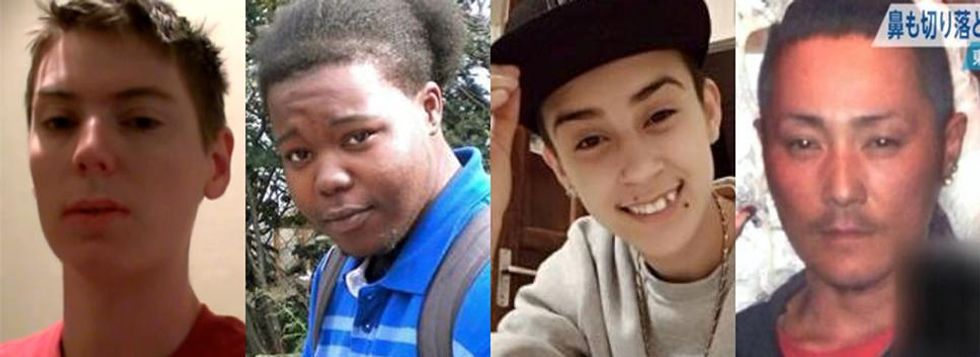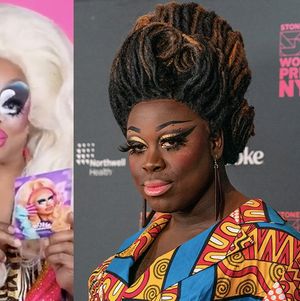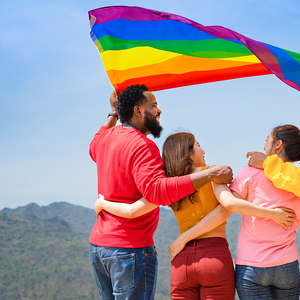As an introductory consideration to the issue of fatal violence against trans men -- particularly through the cases of Kayden Clarke, F. Hilario, Yoshi Tsuchida, Evon Young, and Brandon Teena -- my observations yesterday in "Making Sense Out of the Murders of Trans Men" were hardly exhaustive. I hope, at the very least, they indicate one thing: There's much about this topic that we just don't know yet.

However, beginning to map the areas where we need to know more can offer some guidance of where to go from here. And although we've only learned about these five murders within recent memory, we do have enough information to consider some action steps toward combatting this violence that is all-but-certainly underreported. Here are some launching-off points:
1. De-center whiteness and the English-speaking world from our discussions of trans men and anti-trans violence.
In the U.S. and in most countries worldwide, white people and our lives are the central consideration in the majority of community-wide conversations. That's often the case even when we're discussing issues that affect us, as white people, at proportionally lower rates. The same goes for Western (and more broadly, Anglo) narratives when compared to non-English-speaking and non-Western narratives.
This means, for instance, we're more likely to notice the murders of white, Western trans people, and we're more likely to pass the mike to white, Western people to talk about these trends. In my experience, this holds true for nearly all issues related to trans men -- not just violence, but discussions about our health, our loves, and our lives tend to afford white-passing, English-speaking men the most space.
But if we actively center trans men of color, non-Anglo trans men, and immigrant trans men, our community conversations about violence would necessarily shift in tone and in perceived importance. When we create space for those with disparate experiences to share their truth, our understanding of the nuanced realities inform the lives of those living at the intersection of multiple oppressions will consequently improve, allowing us, as a community, to serve those in need more effectively.
2.Amplify narratives of nonnormative trans men.
The most common story told about trans men in the U.S. -- at least the one I've heard told over and over again -- is that we all access testosterone therapy (and perhaps top surgery), which allows us to pass quickly as male. We get to keep our homes, schooling, and jobs, and then fade into the background of traditional, perk-filled, invulnerable manhood. That story was true for me -- but you'll notice that it likely isn't for the trans men who are murdered or face near-fatal violence.
The centrality of this narrative, however, implicitly tells trans men who have differing stories to keep quiet. Usually, these men's trans identities intersect with them also being nonpassing, nonwhite, feminine, rural, poor, undocumented, or survivors of trauma. Collectively, these and other factors keep such men from being seen as part of the community, and keep their stories and struggles sidelined in favor of the more general discussion, which is deemed more relevant and, in many assumptions, more commonplace. Those of us fortunate enough to have access to such resources -- whether those be financial, educational, or race-based privileges -- must actively create space for the possibility of an existence wholly distinct from our own. This starts simply, making space for such stories -- for such people -- to exist in our imaginations, as well as in our online and physical environments.
3. Engage with local news reports.
As the coverage of Hilario's death in Brazil illustrated -- a local report was translated and brought to U.S. audiences by a trans reporter for Planet Transgender who happened to be fluent in Portuguese -- it is highly possible that additional reports of violence against trans men are appearing in non-English presses. But without a translator, these men's stories will remain unknown to Anglo audiences.
So let's tap into the diverse skill set of our far-reaching community. Bilingual volunteers could translate local newspaper articles about anti-trans violence from around the world. These volunteers could also be connected with local trans activists who can "flag" news reports that include language that indicates the possibility of a trans male murder victim -- for instance, descriptions of the victim's clothing -- and make a concerted effort to dig deeper into the story.
(RELATED: Making Sense Out of the Murders of Trans Men)
When a trans male murder victim is misgendered by local, national, or international news reports, activists could contact the news stations with corrections and encourage others to do so, creating a sense of urgency and strength in numbers that might make news directors look twice. With national and international news outlets all now possessing online presences, it's easier than ever -- unlike, say, in the days of Brandon Teena -- to anonymously "tip" off reporters that a murder victim has possibly been misgendered in their story. Structures to enable this kind of citizen activism and media accountability already exist through organizations like the National Coalition of Anti-Violence Programs and GLAAD, which have a long history of calling out mainstream media's misgendering of, in particular, transgender women who are murdered.
4. Provide fiscal and social support for transgender and trans-centric news outlets, and LGBT-centric outlets that invest resources in trans news beats.
Trans news reporters and news outlets are more likely to care about the cases of trans murder victims, and therefore more likely to spend time and resources covering such cases with care and sensitivity. I say this with some confidence, as a former trans issues correspondent for The Advocate. When these writers' reports receive increased readership -- the all-important "page views" -- it sends a message to the reporters and the organizations they work for that covering trans news is of value to their readership. In turn, those outlets are then more likely to continue covering such stories in the future. Increasing the frequency with which such crimes are reported not only helps improve our communal understanding of the dangers facing part of our community, but is also critical to strengthening community-based problem-solving, which is often based off of lists compiled from these reports. The Transgender Day of Remembrance and the National Coalition of Anti-Violence Programs, for example, are both widely respected gathering sites for information on fatal anti-trans violence -- and both are aggregated largely from newspaper reports.
5. Conduct research on violence against trans men.
Violence against trans men, whether fatal or not, is a multifaceted issue that demands greater understanding. We need to approach this through multiple tracks; although this piece has focused on my area of expertise, examining how the media can help combat such violence, more formal research also plays an important role in understanding what we're up against.
There is a dearth of scholarly, medical, or even demographic research about the lives -- and deaths -- of transgender people both in the U.S. and abroad. That's why we need those who are trained and able to conduct studies, both qualitative and quantitative, that begin the more detailed exploration of how violence plays itself out in the lives of individuals. This effort may be even more effective if it includes revising current research studies that do not have specific questions for trans men and trans women but rather focus on violence as a whole against trans people. Having data sorted by gender identity would allow advocates to more fully understand the unique issues facing trans women and trans men.
6. Foster safe spaces for trans-masculine individuals to discuss violence.
Violence survivors, in general, face intense social pressure to not discuss their experiences. Trans men, both as members of a stigmatized minority (trans) and as members of a gender trained to not express emotion (male), can feel added pressure to keep quiet. The currently pervasive silence around violence toward trans men can keep survivors of nonfatal attacks from creating communal healing. Meanwhile, it erects barriers for community advocates trying to understand more about how and why violence can turn physical and fatal. Our healing and knowledge-gathering efforts remain isolated and transitory.
Safe spaces can be created in both physical and online environments that explicitly address emotional violence, physical violence, sexual assault, racism, police brutality, and other kinds of violence toward trans men. Meanwhile, folks can make trans and LGBT spaces in general more safe for trans-masculine survivors by not using language that assumes any particular or universal experiences for trans men, including assumptions about types or amounts of violence faced.
Ultimately, an issue as complex as fatal violence against trans men needs as many eyes, hearts, and voices on it as possible, which will allow us to understand more in the years to come. Let's continue the conversation.
MITCH KELLAWAY is a white biracial queer trans man who works as a writer and editor. He spent a year as the trans issues correspondent for Advocate.com, and his other writing has appeared in the Lambda Literary Review, Original Plumbing, Mic, Mashable, The Huffington Post, and Everyday Feminism. He is the editor of Boys Do Cry, both an essay series on violence towards trans men and a forthcoming book from Homofactus Press (2017), and coeditor of Manning Up: Transsexual Men on Finding Brotherhood, Family & Themselves (2014, Transgress Press), an anthology of resilience-inspiring narratives by trans men. Reach him at MitchKellaway.com and @MitchKellaway.



















































































